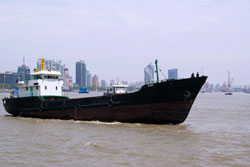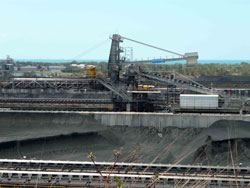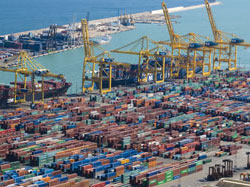| |
Issue 4 : December 2009 |
This is our Christmas issue even if it is rather early. In thanks for that we are being far more optimistic than we have been for the rest of the year. This is also partly thanks to Panos for taking me to task on being too negative. In his words, "it is not so bad. 75 years ago Germany invaded Poland and in just a handful of years 60 million people perished and most of Europe was in ruins..." point taken. Hope is also the point made in Superfreakanomics recently, quoting:
"the main mode of transport produce(s) a slew of by products that economists call negative externalities, including grid-lock, high insurance costs, and far too many traffic fatalities. "
|
 |
Talking about the car? No talking about horses in 1898. No solution seemed possible. An international conference to discuss the problem, one of the first international attempts to solve a "global" problem, broke up in disarray concluding no solution was possible. Within thirty year the problems were gone, eliminated by the cheaper more effective and cleaner car.
Optimism is easily justified if you live in Asia where things are turning around very fast. Some places need to focus on longer term reform and so we have looked at Cabotage this time. The fall out of the crisis may still be coming through in some sectors so a quick look at the slow burning issue of container terminal oversupply is examined briefly. No conclusions just the scale of the problem. To show we can come up with solutions we also look at those lengthening ship queues in Australia.
Just so you know the latest happenings within DWA there is below a short note on risk and arbitration from our new partner Hambleton. As always it will be interesting to get your feedback on our opinions and comments in this newsletter, just contact me on [email protected]
|
Cabotage: The Needs of the Few Triumphing over the Needs of the Many
At present we are involved in two projects where Cabotage is a significant factor in deciding the price of shipping services and hence the structure of a countries logistics networks. The Jones Act (or more correctly The Merchant Marine Act 1920) was passed on the grounds of National Security. The drive of the underlying policy is set out in the preamble to the Act:
"It is necessary for the national defense and for the proper growth of its foreign and domestic commerce that the United States shall have a merchant marine of the best equipped and most suitable types of vessels sufficient to carry the greater portion of its commerce and serve as a naval or military auxiliary in time of war or national emergency"
 |
|
In 1920 the US fleet represented 27% of the world fleet by tonnage; the countries share of world trade by tonnage was about 15%. US flagged ships could carry "the greater portion of" of its imports and exports. In 2008 the US flagged fleet represents 2 % of the world's fleet by tonnage and a fraction of 1% of the container fleet by TEU capacity. The trades to and around the US represented 24% of TEU worldwide carryings. Looking at tankers in 2007 the CIA, a body tasked with assist the defence of the US, identified 59 US flagged tankers over |
1,000 DWT in a world fleet of 4,295 less than 2% of the ships and because of the size of the US flagged tankers a fraction of 1% of the cargo carrying capacity.
Nearly ninety years is a fair timeframe to judge a policy take your own decision on whether The Jones Act a successful one. It is easy to conclude that today the US fleet is capable of carrying only a fraction of its "commerce". It has effectively destroyed the US fleet and its international presence. When the US military require commercial vessels to support military expeditions non-US entities and investors get much of the benefit. Now considered that is successful policy was last reviewed, renewed and re-codified by the US Congress in 2006.
In Indonesia shipping policy seems to be developing a split personality. After years of progress to liberalisation, the introduction of Cabotage restrictions has been pushed to full steam ahead. At the same time they are committed to ASEAN free trade in services which requires liberalisation of the shipping sector. The policy intent is to encourage the growth of an efficient and effective coastal shipping sector; something sorely needed. The impact of the new restrictions will be quite the opposite.
It unfortunately that the new restrictions have coincided with a sea change in the international market forces that inhibited growth from being stimulated by liberalization, the restricted supply of ships and the associated high cost of ships. The last eighteen months has seen this change very quickly. With ships available at good prices liberalisation would now work; assuming Indonesia's ports can let it all happen!
Does this not all justify perverting Spock's dying words? The needs of local shipping owners and operators triumph over the needs of the rest of their own countrymen. Competition in shipping does reduce transport costs and in doing so improves the competitive positions of a countries exports and the cost of importers to consumers. Perhaps Indonesia's split personality is evidence of their very own Dr. McCoy an unknowing attempt to save their friend. For those who don't understand this go and watch "Star Trek: The Search for Spock".
Arbitration and Risk Management
 |
|
Arbitration, claims and dispute resolution are Hambleton's key offerings but the philosophy of Hambleton and the reason for partnering with DWA is prevention is better than cure. They are as active in |
advising clients on the implementation of processes and procedures to minimise and manage project risk to ensure that disputes do not happen as in supporting arbitration.
In a recent appointment, Hambleton carried out a Risk Management Review for a prominent international M&E contractor. Having identified the client's general attitude to risk, through detailed discussion with senior management, they then undertook an objective review of exposures, of procedures for risk identification and containment - including assessment of their effectiveness - and advised on 'gapping' in these measures.
Following this at project level, Hambleton conducted a series of Risk Management Workshops to demonstrate effective procedures for drawing up structured Risk Management Plans. These plans being facilitated by use of the Risk Register module included in ViewPoint, Hambleton's online document management system.
The Risk Register is an effective management tool, designed to be easy to develop and maintain. It promotes the identification of potential risks, their trigger points, their likely impact and the cost of mitigation measures. In housing these within ViewPoint, Hambleton enabled the client to access their latest risk management data, project documentation and correspondence from any location at any time. The improved operational confidence that comes with effective management of risk at both company and project levels is not the only benefit to the client. Efficient containment of risk exposure is now feeding through to significant benefits in negotiating premiums with insurers.
To learn more about Hambleton's services or ViewPoint please contact Ben Thomson on [email protected]
Ship Queues, Miners and Inefficiency
 |
|
On a recent visit to Dalrymple Bay Coal Terminal, which the week I visited was claiming to be the world's biggest at about 90 mtpa, there were 78 ships waiting to load. Average waiting time was just under a calendar month. 78 ships or about US$ 6 billion sitting idle. Why, the media often ask, is this allowed? Surely the port can do better? The mines using the terminal are outspoken about the lack of capacity. Surely they say the port can do better? Most people seem happy to blame the port though I bet the port does not enjoy it at all! |
Always one for the underdog, even when it does have a replacement value over US$ 5 billion, I thought I would have a look into the situation and at the same time follow up on work I had done a few years ago. It took me no time at all to come up with an easy and cheap way to add 25%+ to the capacity of the terminal; almost overnight. What a genius! Simple when you realised that ships have to keep their propellers 75% in the water at all times, an interesting and costly regulation making them spend 24 hours alongside de-ballasting.
The aim of the regulation is to ensure the ship can be underway and have steerage at any time. It was set by the Harbour Master who is not involved in the commercial operation of the port; their duty is ensuring safety. The regulation is not unique to Queensland but is unusual. In an off the record chat with officials they recognise it is not the only safe solution. Change the regulation you increase the capacity of the terminal, resolve the problem and the ships queue disappears. Well, No.
So a 25% increase in terminal capacity does not solve the problem, I found out later that when there is coal it operates closer to 130 mtpa, cannot be a terminal issue then. That is a view reinforced when you consider that the day I was there the terminal unable to load ships because they had no coal in the stockpiles. No trains were bringing coal into the terminal either. Queensland Rail's maintenance and upgrade program I believe was the cause. So why not blame the railway? Perhaps that is the benefit of a close link to Government.
The queuing situation is far more complex than the media in Australia let on; it involves mines, railways, regulators, Government and to a lesser extent the terminal; so much for the media view.
There are perhaps ways to manage the queue out of existence. Coal is currently sold FOB (Free On Board), when demurrage rates are hitting all time lows and the price of coal is rising there is little incentive on the mines to manage their sale to match the available capacity; hence queues that grow ever longer. If coal were sold CIF (Cost Including Freight) the mines would have a strong incentive to make sure that ship waiting time was minimised. Clearly they would argue that this places a lot higher risk on them, restricts their sales and reduces the revenue of the Queensland Government. It would however make more efficient use of existing assets, eliminate the queues and protect the environment from potentially catastrophic damage (imagine the waiting ships aground on the reef).
Excess Capacity and the Length of the Overhang
The capacity overhang in the shipping industry is the monkey on the back that everyone knows about. Any thought of traffic growth or rate recovery just reminds you that there are a lot of new ships doing very little. Hopefully new markets could draw down some tonnage, the Indonesia and India domestic markets must be good for strong growth at some stage.
The situation in the port industry is perhaps less discussed; the container terminal business in particular. Many ports and terminals are used to cyclic markets. Coal, grain and oil terminals whilst perhaps not comfortable have at least experienced downs as well as ups. Container Terminals particularly in Asia have sometimes given the impression that they are a Field of Dreams, "Build it and they will come". I saw recently a presentation from Hutchison using that very theme.
 |
|
Perhaps this Field of Dreams is most evident in Vietnam, terminals from PSA, CMA-CGM, APMT, SSA, DP World all coming on stream and I forgot the other two or three! China also has had its share of dreams. Recently I had cause to look at the supply demand balance for container terminals in both countries. Picking three key port regions the table sets out some idea of when the supply demand balance may come back into balance. To be reasonable we have allowed for some productivity improvements over time within the existing capacity. |
| Port Region |
Overcapacity 2010 |
2012 Capacity |
Supply/Demand Back in Balance |
| Stagnation1 |
Moderate Growth2 |
Strong Growth3 |
| Yangtze River Delta |
40% |
42 m |
2019 |
2013 |
2012 |
| Pearl River Delta |
72% |
50 m |
2023 |
2016 |
2013 |
| Southern Vietnam |
50% |
12 m |
2030+ |
2024 |
2018 |
1Stagnation means US and Europe struggle to recover over next three to five years
2Moderate Growth US and Europe recover at modest rate over next three to five years
3Return to pre-crisis growth in 2011
Serious numbers aren't they. Handling rates are under pressure and you cannot help but feel they come under more pressure yet. The shipping market has already shown one company's problem do become the whole sectors problems. Terminals are not immune to the spread of the infection.
Phoenix from the Ashes
My coffee shops is no longer the empty quiet place it was nine months ago, proof positive that the recession is over in Singapore. In fact the 10% growth in Q3 suggests more an economy taking off like a rocket. That seems to be reflected in our own sales figures. Quiet for the first six months, we now have a stronger order book than this time last year and are interviewing staff once more. Prospects for further orders look strong into the New Year.
|